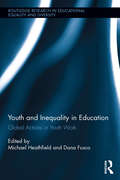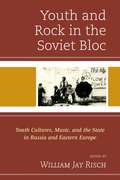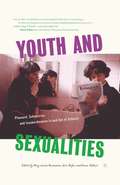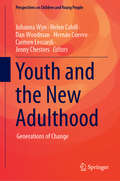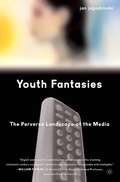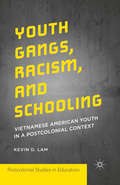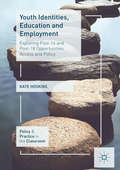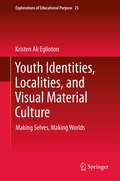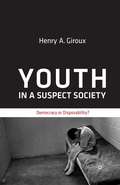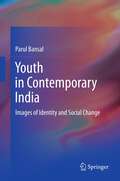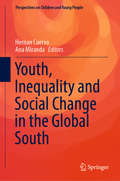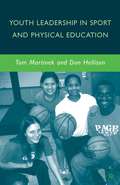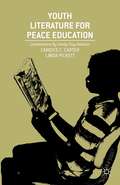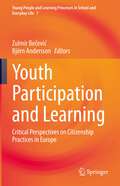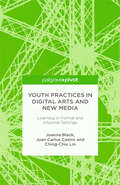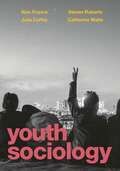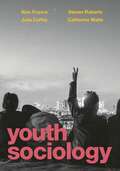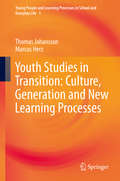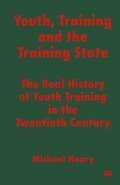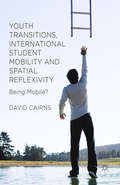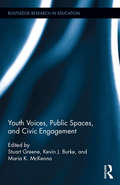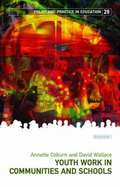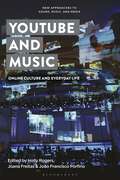- Table View
- List View
Youth and Inequality in Education: Global Actions in Youth Work (Routledge Research in Educational Equality and Diversity)
by Dana Fusco Michael HeathfieldThe transition to adulthood for many is mediated by class, culture, and local/global influences on identity. This volume analyzes the global injustices that create inequities and restrict future opportunities for young people during this transitional time, including poverty, unemployment, human rights, race, ethnicity and location. It critically examines global instances of youth discrimination, offering positive strategies and practices such as youth work that successfully remediate these injustices. With international contributions from Aotearoa New Zealand, Australia, England, Malaysia, Peru, Philippines, Portugal, Morocco, Jordan and the U.S., this volume is particularly important to researchers and scholars in the fields of youth studies, education, and social work.
Youth And Rock In The Soviet Bloc (PDF): Youth Cultures, Music, And The State In Russia And Eastern Europe
by Zhuk Risch Christopher Ward Sergei Zhuk Polly McMichael Gleb Tsipursky Tom Junes Jonathyne Briggs Kate Gerrard Sandor Horvath Gregory Kveberg William Risch David Tompkins Dean VuleticYouth and Rock in the Soviet Bloc explores the rise of youth as consumers of popular culture and the globalization of popular music in Russia and Eastern Europe. This collection of essays challenges assumptions that Communist leaders and Western-influenced youth cultures were inimically hostile to one another. While initially banning Western cultural trends like jazz and rock-and-roll, Communist leaders accommodated elements of rock and pop music to develop their own socialist popular music. They promoted organized forms of leisure to turn young people away from excesses of style perceived to be Western. Popular song and officially sponsored rock and pop bands formed a socialist beat that young people listened and danced to. Young people attracted to the music and subcultures of the capitalist West still shared the values and behaviors of their peers in Communist youth organizations. Despite problems providing youth with consumer goods, leaders of Soviet bloc states fostered a socialist alternative to the modernity the capitalist West promised. Underground rock musicians thus shared assumptions about culture that Communist leaders had instilled. Still, competing with influences from the capitalist West had its limits. State-sponsored rock festivals and rock bands encouraged a spirit of rebellion among young people. Official perceptions of what constituted culture limited options for accommodating rock and pop music and Western youth cultures. Youth countercultures that originated in the capitalist West, like hippies and punks, challenged the legitimacy of Communist youth organizations and their sponsors. Government media and police organs wound up creating oppositional identities among youth gangs. Failing to provide enough Western cultural goods to provincial cities helped fuel resentment over the Soviet Union's capital, Moscow, and encourage support for breakaway nationalist movements that led to the Soviet Union's collapse in 1991. Despite the Cold War, in both the Soviet bloc and in the capitalist West, political elites responded to perceived threats posed by youth cultures and music in similar manners. Young people participated in a global youth culture while expressing their own local views of the world.
Youth and Sexualities: Pleasure, Subversion, and Insubordination In and Out of Schools
by M. Rasmussen E. Rofes S. TalburtA new collection that addresses the problematic pathologization of queer youth, this book argues that the majority of educators and youth workers still know little about queer youth's negotiations of identity and community. The contributors examine the dangerous effects of heteronormalizing practices, and look at how young people negotiate labels and stereotypes in and out of school settings. What makes this project unique is that the contributors go beyond the discussions of homophobia young people experience on an everyday basis - the look at how youth subvert these experiences into those of pleasure, power, and confidence. In addition, the contributors look at how youth organize communities and negotiate positive identities in different settings.
Youth and the New Adulthood: Generations of Change (Perspectives on Children and Young People #8)
by Johanna Wyn Helen Cahill Dan Woodman Hernán Cuervo Carmen Leccardi Jenny ChestersThis book investigates the life trajectories of Generation X and Y Australians through the 1990s and 2000s. The book defies popular characterizations of members of the ‘precarious generations’ as greedy, narcissistic and self-obsessed, revealing instead that many of the members of these generations struggle to reach the standard of living enjoyed by their parents, value learning highly and are increasingly concerned about the environment and the legacy current generations are leaving for their children and remain optimistic in the face of considerable challenges. Drawing on data from the Life Patterns longitudinal study of Australian youth (an internationally recognized study), the book tells the story of members of these ‘precarious generations’. It examines significant dimensions of young people’s lives across time, comparing how domains such as health and well-being, education, work and relationships intersect to produce the complex outcomes that characterize the lives of members of each of these generations. It also explores the strategies these generations use to make their lives and the ways in which they remain resilient. While the book is based on Australian data, the analysis draws on and contributes to the international literature on young people and social change.
Youth Cultures in a Globalized World: Developments, Analyses and Perspectives
by Hannes Krall Gerald KnappThis book examines the relation between the phenomenon of globalization, changes in the lifeworld of young people and the development of specific youth cultures. It explores the social, political, economic and cultural impact of globalization on young people. Growing diversity in their lifeworlds, technological development, migration and the ubiquity of digital communication and representation of the world open up new forms of self-representation, networking and political expression, which are described and discussed in the book. Other topics are the impact of globalization on work and economy, global environmental issues such as climate change, political movements which put “nationalism first”, change of youth`s values and the significance of body, gender and beauty. The book highlights the challenges of young people in modern life, as well as the way in which they express themselves and engage in society – in culture, politics, work and social life.
Youth Fantasies: The Perverse Landscape of the Media
by Jan JagodzinskiYouth Fantasies is a collection of studies conducted in cross-cultural collaboration over the past ten years that theorizes 'youth fantasy'; as manifested through the media of TV, film, and computer games. Unlike other media studies and education books, the authors employ both Lacanian and Kleinian psychoanalytic concepts to attempt to make sense of teen culture and the influence of mass media. The collection includes case studies of X-Files fans, the influence of computer games and the 'Lara Croft' phenomenon, and the reception of Western television by Tanzanian youth. The authors see this book as a much needed reconciliation between cultural studies and Lacanian psychoanalysis, and attempt to highlight why Lacan is important to note when exploring youth fantasy and interest in the media, especially in shows like X-Files .
Youth Gangs, Racism, and Schooling: Vietnamese American Youth in a Postcolonial Context (Postcolonial Studies in Education)
by Kevin D. LamWinner of the American Educational Studies Association 2016 Critics' Choice Book AwardYouth Gangs, Racism, and Schooling examines the formation of Vietnamese American youth gangs in Southern California. Lam addresses the particularities of racism, violence, and schooling in an era of anti-youth legislation and frames gang members as post-colonial subjects, offering an alternative analysis toward humanization and decolonization.
Youth Identities, Education and Employment: Exploring Post-16 and Post-18 Opportunities, Access and Policy (Policy and Practice in the Classroom)
by Kate HoskinsThis book investigates how policy, family background, social class, gender and ethnicity influence young people’s post-16 and post-18 employment and education access. It draws on existing literature, alongside new data gathered from a case study in a UK state secondary school, to examine how policy changes to the financial arrangements for further and higher education and the changing youth employment landscape have had an impact on young people’s choices and pathways. Hoskins explores a number of topics, including the role of identity in young people’s decision-making; the impact of changes to young people’s financial arrangements, such as cuts to the Education Maintenance Allowance and increased university fees; and the influence of support from parents and teachers. The book will be of interest to students and researchers of Education and Sociology.
Youth Identities, Localities, and Visual Material Culture: Making Selves, Making Worlds (Explorations of Educational Purpose #25)
by Kristen Ali EglintonThis invaluable addition to Springer’s Explorations of Educational Purpose series is a revelatory ethnographic account of the visual material culture of contemporary youths in North America. The author’s detailed study follows apparently dissimilar groups (black and Latino/a in a New York City after-school club, and white and Indigenous in a small Canadian community) as they inflect their nascent identities with a sophisticated sense of visual material culture in today’s globalized world. It provides detailed proof of how much ethnography can add to what we know about young people’s development, in addition to its potential as a model to explore new and significant avenues in pedagogy. Supported by a wealth of ethnographic evidence, the analysis tracks its subjects’ responses to strikingly diverse material ranging from autobiographical accounts by rap artists to the built environment. It shows how young people from the world’s cultural epicenter, just like their counterparts in the sub-Arctic, construct racial, geographic and gender identities in ways that are subtly responsive to what they see around them, blending localized characteristics with more widely shared visual references that are now universally accessible through the Web. The work makes a persuasive case that youthful engagement with visual material culture is a relational and productive activity that is simultaneously local and global, at once constrained and enhanced by geography, and possesses a potent and life-affirming authenticity. Densely interwoven with young people’s perspectives, the author’s account sets out an innovative and interdisciplinary conceptual framework affording fresh insights into how today’s youth assimilate what they perceive to be significant.Supported by a wealth of ethnographic evidence, the analysis tracks its subjects’ responses to strikingly diverse material ranging from autobiographical accounts by rap artists to the built environment. It shows how young people from the world’s cultural epicenter, just like their counterparts in the sub-Arctic, construct racial, geographic and gender identities in ways that are subtly responsive to what they see around them, blending localized characteristics with more widely shared visual references that are now universally accessible through the Web. The work makes a persuasive case that youthful engagement with visual material culture is a relational and productive activity that is simultaneously local and global, at once constrained and enhanced by geography, and possesses a potent and life-affirming authenticity. Densely interwoven with young people’s perspectives, the author’s account sets out an innovative and interdisciplinary conceptual framework affording fresh insights into how today’s youth assimilate what they perceive to be significant.Supported by a wealth of ethnographic evidence, the analysis tracks its subjects’ responses to strikingly diverse material ranging from autobiographical accounts by rap artists to the built environment. It shows how young people from the world’s cultural epicenter, just like their counterparts in the sub-Arctic, construct racial, geographic and gender identities in ways that are subtly responsive to what they see around them, blending localized characteristics with more widely shared visual references that are now universally accessible through the Web. The work makes a persuasive case that youthful engagement with visual material culture is a relational and productive activity that is simultaneously local and global, at once constrained and enhanced by geography, and possesses a potent and life-affirming authenticity. Densely interwoven with young people’s perspectives, the author’s account sets out an innovative and interdisciplinary conceptual framework affording fresh insights into how today’s youth assimilate what they perceive to be significant.
Youth in a Suspect Society: Democracy or Disposability?
by H. GirouxThrough the lens of education, this book attempts to situate young people within a number of theoretical and political considerations that offer up a new 'analytic of youth', one that posits not only the emergence of a new way to talk about youth but also a new language for understanding the politics that increasing frame their lives.
Youth in Contemporary India: Images of Identity and Social Change
by Parul BansalThis book endeavors to be a study of identity in Indian urban youth. It is concerned with understanding the psychological themes of conformity, rebellion, individuation, relatedness, initiative and ideological values which pervade youths’ search for identity within the Indian cultural milieu, specifically the Indian family. In its essence, the book attempts to explore how in contemporary India the emerging sense of individuality in youth is seeking its own balance of relationality with parental figures and cohesion with social order. The research questions are addressed to two groups of young men and women in the age group of 20-29 years-Youth in Corporate sector and Youth in Non Profit sector. Methodologically, the study is a psychoanalytically informed, process oriented, context sensitive work that proceeds via narrations, conversations and in-depth life stories of young men and women. Overall, the text reflects on the nature of inter-generational continuity and shifts in India.
Youth, Inequality and Social Change in the Global South (Perspectives on Children and Young People #6)
by Hernan Cuervo Ana MirandaThis book gathers international and interdisciplinary work on youth studies from the Global South, exploring issues such as continuity and change in youth transitions from education to work; contemporary debates on the impact of mobility, marginalization and violence on young lives; how digital technologies shape youth experiences; and how different institutions, cultures and structures generate a diversity of experiences of what it means to be young. The book is divided into four broad thematic sections: (a) Education, work and social structure; (b) Identity and belonging; (c) Place, mobilities and marginalization; and (d) Power, social conflict and new forms of political participation of youth.
Youth Leadership in Sport and Physical Education
by D. Hellison T. MartinekThis book responds to the needs of urban youth by describing youth development principles in physical activity programs. These programs are built on urban kids' assets and promise rather than their deficits. Included are ways of transferring skills from specific programs to everyday settings.
Youth Literature for Peace Education
by C. Carter L. PickettCarter and Pickett explore how educators and families can teach peace education through youth literature and literacy development. Showing how to assess, choose, and make use of literature that can be used to teach both literacy and peace education, they walk through individual methods: recognizing and teaching different portrayals of conflict in youth literature, analyzing characterization, and examining the role of illustrations. Educators who want to incorporate peace education within a broader, literacy-focused curriculum, and peace educators looking for age-appropriate materials and methodologies will find Youth Literature for Peace Education a rich and interdisciplinary resource.
Youth Participation and Learning: Critical Perspectives on Citizenship Practices in Europe (Young People and Learning Processes in School and Everyday Life #7)
by Zulmir Bečević Björn AnderssonThis book contributes to the studies on learning processes occurring outside “traditional” socialization settings such as family and school, by analysing civic and political participation and learning experiences. In this perspective, the book delves into the connections between the concepts of learning and participation and, in various ways and from different perspectives, critically interrogates learning and participation as interrelated phenomena, with the aim of revealing complexities implicated in pathways to adulthood. Being interdisciplinary in its nature (contributors come from disciplinary backgrounds such as educational sciences, child and youth studies, social work, sociology and political science), the volume provides an up-to date analysis of contemporary issues connected to youth participation and learning. The work taps into central areas of everyday life of young people and youth meaning-making and generates and presents qualitative knowledge about what it means to be young in Europe today.
Youth Practices in Digital Arts and New Media: Learning In Formal And Informal Settings
by J. Black J. Castro C. LinThe authors examine youths' practices in digital culture affecting social change, pedagogy, and creative learning practices. Knowledge about these practices is discussed, in which learning, knowledge sharing, distinct social contexts, pedagogical relationships, and artistic creative inquiry are examined in diverse formal and informal environments.
Youth Sociology
by Julia Coffey Steven Roberts Alan France Catherine WaiteFalling somewhere between childhood and adulthood, ‘Youth’ is a key period of transition. It can be difficult to define and make sense of this period in one’s life. However it is categorised, young people face a number of challenges and issues growing up in today’s world. From the pressures created by social media to the increasing precarity of employment, the major social, cultural and economic developments of our time are each impacting this period of the lifecourse in myriad ways. Youth Sociology helps readers to understand how such changes factor into the experience of being young today, and illuminates the realities of the world in which young people live. Embedding perspectives and insights from a wide range of disciplines beyond sociology, this authoritative new textbook will be incredibly useful for all students of youth.
Youth Sociology
by Alan France Julia Coffey Steven Roberts Catherine WaiteFalling somewhere between childhood and adulthood, 'Youth' is a key period of transition. It can be difficult to define and make sense of this period in one's life.However it is categorised, young people face a number of challenges and issues growing up in today's world. From the pressures created by social media to the increasing precarity of employment, the major social, cultural and economic developments of our time are each impacting this period of the lifecourse in myriad ways. Youth Sociology helps readers to understand how such changes factor into the experience of being young today, and illuminates the realities of the world in which young people live.Embedding perspectives and insights from a wide range of disciplines beyond sociology, this authoritative new textbook will be incredibly useful for all students of youth.
Youth Studies in Transition: Culture, Generation and New Learning Processes (Young People and Learning Processes in School and Everyday Life #1)
by Thomas Johansson Marcus HerzThis book provides an updated and fresh introduction to recent theoretical developments in youth studies. It expands upon these developments and introduces new discussions and perspectives. It presents three central theoretical traditions in youth studies, and explores the possibilities of redefining some of the central concepts, but also of combining different theoretical perspectives. After depicting the theoretical landscape of youth studies, the book explores generations and new subjectivities. Next, it examines subcultures and transitional spaces, mediatization and learning processes. One chapter is set aside for a discussion on the body, the self and habitus, and this is followed by a chapter on postcolonial spaces. Before presenting its conclusions, the book delves into the development of youth studies, theory and everyday life. All together the book taps into what is happening in the everyday lives of young people, and employs a methodology that can be used to create bridges between young people’s voices and experiences on the one hand and societal and cultural transformations on the other.
Youth, Training and the Training State: The Real History of Youth Training in the Twentieth Century
by Michael NearyThis work uncovers the real history of modern youth, providing an explanation of its predicament that goes beyond the mainstream accounts as perpetrated by the sociology of youth. Tracing the development of training of young workers from 1814 the book reveals, for the first time, the creation by post-war legislation of the modern category of 'youth'. The book concludes that with the prevailing conditions of employment there is no longer any future for youth as 'youth'. The recent history of 'youth' is an attempt to recompose a sustainable existence for itself and society.
Youth Transitions, International Student Mobility and Spatial Reflexivity: Being Mobile?
by D. CairnsDrawing on comparative country case studies, this book explores student mobility in Europe, incorporating original theoretical perspectives to explain how mobility happens and new empirical evidence to illustrate how students become mobile within their present educational and future working lives.
Youth Voices, Public Spaces, and Civic Engagement (Routledge Research in Education)
by Stuart Greene Kevin J. Burke Maria K. McKennaThis collection of original research explores ways that educators can create participatory spaces that foster civic engagement, critical thinking, and authentic literacy practices for adolescent youth in urban contexts. Casting youth as vital social actors, contributors shed light on the ways in which urban youth develop a clearer sense of agency within the structural forces of racial segregation and economic development that would otherwise marginalize and silence their voices and begin to see familiar spaces with reimagined possibilities for socially just educational practices.
Youth Voices, Public Spaces, and Civic Engagement (Routledge Research in Education #159)
by Stuart Greene Kevin J. Burke Maria K. McKennaThis collection of original research explores ways that educators can create participatory spaces that foster civic engagement, critical thinking, and authentic literacy practices for adolescent youth in urban contexts. Casting youth as vital social actors, contributors shed light on the ways in which urban youth develop a clearer sense of agency within the structural forces of racial segregation and economic development that would otherwise marginalize and silence their voices and begin to see familiar spaces with reimagined possibilities for socially just educational practices.
Youth Work in Communities and Schools (Policy And Practice In Education Ser. #28)
by Annette Coburn David WallaceWorking across professional and disciplinary boundaries, young people and youth workers collaborate to create powerful learning environments in communities, schools and other settings. The authors explore how youth work, as a critical and problem-posing pedagogy, enables young people to transform their lives
YouTube and Music: Online Culture and Everyday Life (New Approaches to Sound, Music, and Media)
by Holly Rogers, Joana Freitas and João Francisco PorfírioYouTube has afforded new ways of documenting, performing and circulating musical creativity. This first sustained exploration of YouTube and music shows how record companies, musicians and amateur users have embraced YouTube's potential to promote artists, stage performances, build artistic (cyber)identity, initiate interactive composition, refresh music pedagogy, perform fandom, influence musical tourism and soundtrack our everyday lives. Speaking from a variety of perspectives, musicologists, film scholars, philosophers, new media theorists, cultural geographers and psychologists use case studies to situate YouTube as a vital component of contemporary musical culture. This book works together with its companion text Remediating Sound: Repeatable Culture, YouTube and Music.The ebook editions of this book are available open access under a CC BY-NC-ND 4.0 licence on bloomsburycollections.com. Open access was funded by Knowledge Unlatched.
